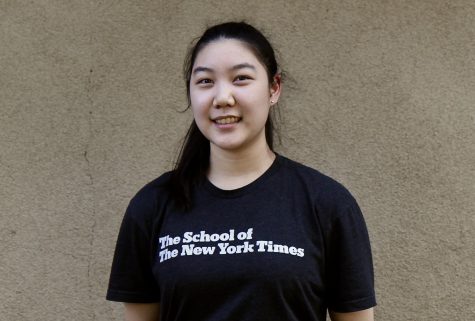It’s a twin thing: affects one of us, affects both of us
The white silhouette is a rhythmic gymnast with an injury on her foot. Mirroring her is an artistic gymnast, representing the writer, Audrey Wong and her twin sister
October 27, 2019
Correction after correction. Anger and frustration surge through my body as I try to perfect my routine for the hundredth time. After each iteration, my mind replays the same questions: Why am I not good enough? Why am I not strong enough, flexible enough or fit enough to perform these seemingly simple skills? Frustrated that my body was not capable of doing what I asked, I ask myself: if other gymnasts are able to do it, why can’t I?
In my quest for improvement, I put myself through endless grueling practices to the point where I was unable to move the next day. I was never satisfied with what I had accomplished and constantly wanted to improve. I never appreciated the fact that I was healthy enough to continue doing what I loved.
In true twin fashion, my twin sister Caitlyn had similar ambitions in artistic gymnastics. However, she never experienced a day where she wasn’t in pain because; she was born with an innate injury that, to this day has not been cured. By being there for her through her struggles, I learned a valuable lesson that most take for granted: be grateful for what you have.
My sister was born with clubfeet, a condition in which the feet are turned inwards and appear twisted. As a child, Caitlyn had to wear orthopedic braces to correct this issue. Our parents thought her clubfeet would correct themselves as she grew up, but in fourth grade, Caitlyn began noticing pain in her foot and heel. As gymnasts, we both dismissed the issue since the sport thrives on the idea of “no pain, no gain,” and she continued to practice. Even as the pain increased and hindered her ability to walk, she pushed through, ignoring it to pursue her passion for gymnastics. But eventually, it became unbearable. Our parents took her to a doctor, and we discovered that she suffered from severe flat feet, a condition in which the arch of the foot collapses, and triggers plantar fasciitis, the inflammation of the tendon that connects the heel to the toe. The doctor also told her that she had an extra bone in her foot and, because of her flat feet, that bone kept scraping the floor.
While we thought her pain would ease over time, it only got worse as she grew up. In middle school, Caitlyn was excused from running and walking during P.E. class. However, on Fridays, she was still required to participate in Mile Club, in which she would have to walk two miles. The extra exertion on her foot worsened her pain, making gymnastics practice even more difficult.
She tried to perform as many skills as she could by wrapping her foot in athletic tape in order to ease the pain, but this method only worked to a certain extent. Afterward, no matter what she tried, nothing alleviated the pain. She would purposely fall out of skills (not land properly) to avoid landing on her feet. Sharp, stabbing pain left her limping to the car after practices. My family did everything that we could to prevent her pain from worsening, from soaking her feet in ice to taping her feet for more support, but she still had a passion for gymnastics; she wanted to pursue a sport that was low-impact yet still reminiscent of artistic gymnastics. Soon, she discovered an alternative: diving, a sport that required no landings and didn’t require the use of her feet. Caitlyn tried the sport and liked it, but nothing could replace the joy that artistic gymnastics brought her.
A few months after starting diving, she was scheduled for her first surgery on her right foot to shave down part of the extra bone in her arch. When she returned from recovery, she realized that diving was not her passion, and that she truly wanted to return to gymnastics. She began the transition to rhythmic gymnastics, which is a lower impact sport compared to artistic gymnastics. While Caitlyn still loved artistic gymnastics, her injury restricted her solely to the rhythmic alternative.
As her sister and fellow gymnast, I understand the sacrifices that athletes have to make. Gymnastics is by no means an easy sport. It pushes athletes’ body into doing things that they could never imagine, such as climbing a rope two stories tall without the use of your feet while being weighed down by weights. Everything I experienced was exponentially harder for Caitlyn because of her innate injury. Something that seemed so insignificant was the dealbreaker between continuing a sport or quitting.
I was constantly wrapped up in thinking, “if I were born with a different body, it would be easier to master skills.” But, I never realized how grateful I should be for what I already have. After all, I didn’t have an injury that would stick with me for the rest of my life, preventing me from doing a sport that I loved. Caitlyn’s injury made me realize how something you take for granted is sometimes what others wish they could have, such as simply having healthy feet. When I go out on runs or cycle, I always think back to how much pain I could be in, but am fortunate enough to not experience.



































































Patricia • Nov 5, 2019 at 10:03 pm
love you audrey! so proud of you! an amazing article